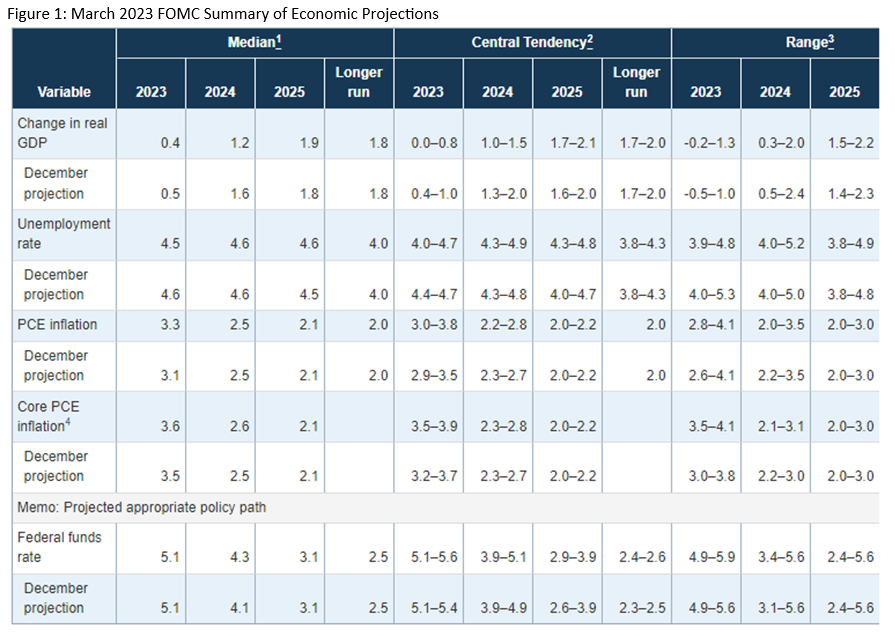-
Email
Linkedin
Facebook
Twitter
Copy Link

Loading...
The Fed made another 25 basis point rate hike in March and pushed the Fed Funds window to 4.75 – 5.00 percent. Additionally, the Fed elected not to change its program of reducing its holdings of Treasury securities, agency debt, and agency mortgage backed securities (aka Quantitative Tightening). However, the decision to leave the program intact wont prevent the Fed’s balance sheet from continuing to swell due to the introduction of the emergency lending facilities to counter the banking crisis (more here). Chair Powell said that that monetary policy decisions will continue to be made on a meeting-by-meeting basis. However, the SEP indicates that the Fed will hike just once more (25 bps) before holding rates steady for the remainder of 2023. On the banking crisis, Chair Powell said that an internal investigation is being launched to determine how the Fed missed the failure of Silicon Valley Bank and that he welcomed and expected outside probes. He also noted that the subsequent banking crisis resulted in tighter credit conditions that were actually doing the Fed’s monetary tightening work for it. Finally, Chair Powell noted that the US banking system is “strong, sound, resilient, and well capitalized.” The Federal Reserve’s Summary of Economic Projections (SEP) anticipates slower real GDP growth over the forecast horizon (Figure 1). The FOMC projects 4q/4q 2023 GDP growth of 0.4 percent and 4q/4q 2024 GDP growth of 1.2 percent. These are downgrades from the growth expectations that were released in December. We forecast -0.6 and 2.2 for these two periods, respectively. The FOMC also raised its expectations for inflation. The FOMC projects 4q/4q 2023 PCE inflation of 3.3 percent and 4q/4q 2024 of 2.5 percent. We forecast 3.1 and 2.0 for these two periods, respectively. The Fed’s GDP expectations are too optimistic, in our view. Our base case assumption is that the Fed Funds rate will rise to a mid-point of 5.375 percent at the end of 2023 and fall to 3.875 percent in at the end of 2024, vs. the March SEP’s 5.1 percent and 4.3 percent. Our projection for steeper cuts to the Fed Funds rate in 2024 are predicated on the US falling into a recession this year that helps to cool inflation. This, in our view, will give the Fed more room to cut rates next year.Insights for What’s Ahead
What Were the Fed’s Actions?
What Does This Mean for the US Economy?

Retail Sales Show Consumers Stock Up ahead of Tariffs
April 16, 2025
US Seeks Shipbuilding Revival, Muting of China Dominance
April 14, 2025
March CPI May Hint at Consumer Pullback as Tariffs Rise
April 10, 2025
The US-China Trade War Escalates
April 09, 2025
Reciprocal Tariffs Will Weaken US and Global Economies
April 03, 2025
Charts
Preliminary PMI indices show no change in weak DM growth momentum in November
LEARN MORECharts
Members of The Conference Board can access all underlying data of the Job Loss Risk Index by Industry in this Excel workbook.
LEARN MORECharts
While a US recession appears to be imminent, it will not look like any other in recent history.
LEARN MORECharts
CEOs’ views of current and future economic conditions remain pessimistic as they prepare for near-inevitable US and EU recessions.
LEARN MORECharts
The US economy appears to be on the precipice of recession.
LEARN MORECharts
Measure of CEO Confidence declined for the fifth consecutive quarter in Q3 2022 and has hit lows not seen since the start of the COVID-19 pandemic in 2020.
LEARN MOREPRESS RELEASE
US Leading Economic Index® (LEI) Fell in March
April 18, 2024
PRESS RELEASE
US Consumer Confidence Little Changed in March
March 26, 2024
PRESS RELEASE
US Leading Economic Index® (LEI) Inched Up in February
March 21, 2024
PRESS RELEASE
US Consumer Confidence Retreated in February
February 27, 2024
PRESS RELEASE
US Leading Economic Index® (LEI) Fell Further in January
February 20, 2024
PRESS RELEASE
CEO Confidence Improved in Q1 2024
February 08, 2024
